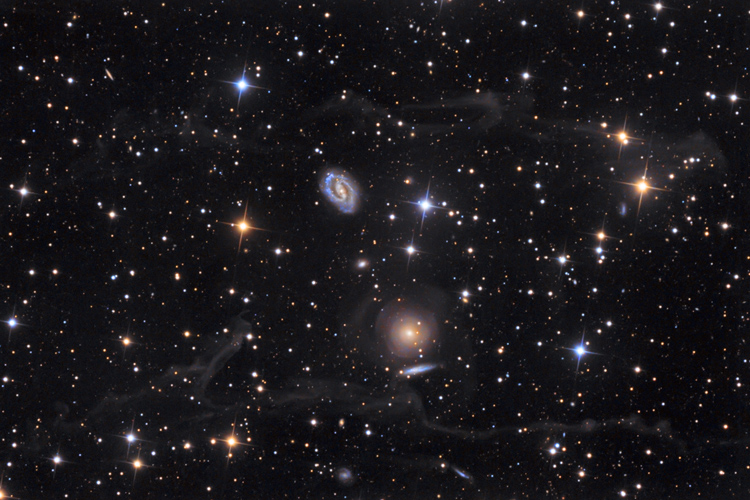|
Home
Recent Images
Galaxies
Nebulae
Natural Color
Narrow Band
H-Alpha
Clusters
Comets
Solar System
Observatory
Equipment
My Freeware
Tips & Tricks
Published Images
Local Weather
Terrestrial
Send Email
|
NGC 2633 & 2634

Click the image for a half size
view. (1733 x 1182 - 1.0 MB)
|
Instrument |
12.5" RCOS @
~f/9 (2880 mm fl) at 0.64 arcsec/pixel. Shown at 1.28 and 3.03 arcsec/pixel. |
|
Mount |
Paramount ME |
|
Camera |
SBIG STL-11000 w/
FW8 filter wheel, AstroDon Gen-2 Filters |
|
Acquisition Data |
3/21/2014
to 6/19/2014 Chino Valley, AZ... with CCD Commander & CCDSoft. |
|
Exposure |
Lum 1050 min. (35
x 30 min. bin 1x1)
RGB 720 min. ( 16
x 15 min. bin 2x2, each) |
|
Software & Processing Notes |
-
CCDSoft, CCDStack,
Photoshop CS6, PixInsight and Noel Carboni's actions.
-
No SDSS stars were
available for color balancing, so a standard image-train color
calibration was used, as determined by
eXcalibrator v4.25, and then adjusted for altitude
extinction.
-
CCDBand-Aid to repair
KAI-11000M vertical bars.
-
CCDStack to
calibrate, register, normalize, data reject, combine the sub
exposures, create the RGB image.
-
PixInsight for
gradient removal, initial non-linear stretching and selective
use of HDRMultiscaleTrans to enhance the detail in the center of
the galaxies.
-
PhotoShop for the
LRGB combine & final touch-up.
-
Noiseware 5, a
PhotoShop plug-in.
|
|
Comment |
The field of view is
rotated 35 degrees counter-clockwise
This group of galaxies
is located in the constellation Camelopardalis. At the top, is the
spiral galaxy NGC 2633, at a distance of 98 million light years.
Below is the shell galaxy NGC 2634 and nearby 2634A. NGC 2634 is at
a distance of about 103 million light-years and NGC 2634A is at 95
million.The shells around NGC 2634 are very recent discovery in
2000.
Although these three galaxies are at similar distances and in the
same general direction, they are not interacting with each other.
Also shown in the image are two interesting dust lanes of the
integrated flux nebula. |
|